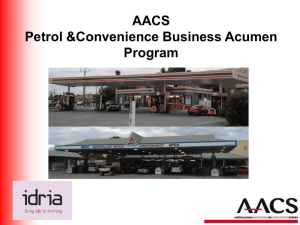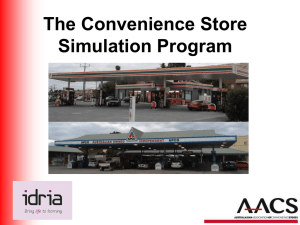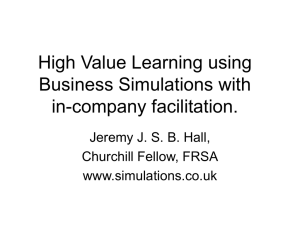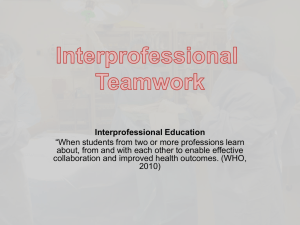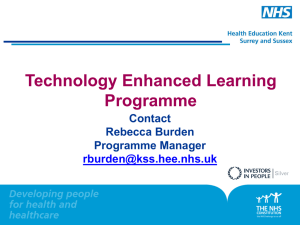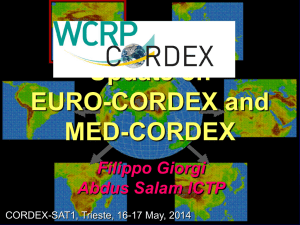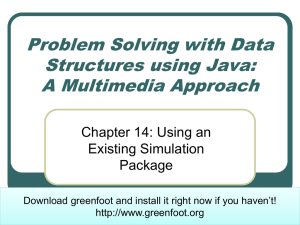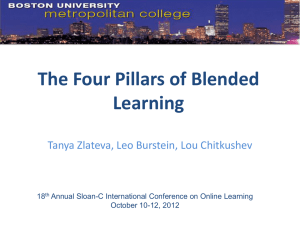Presentation - Staffordshire University Blogs
advertisement
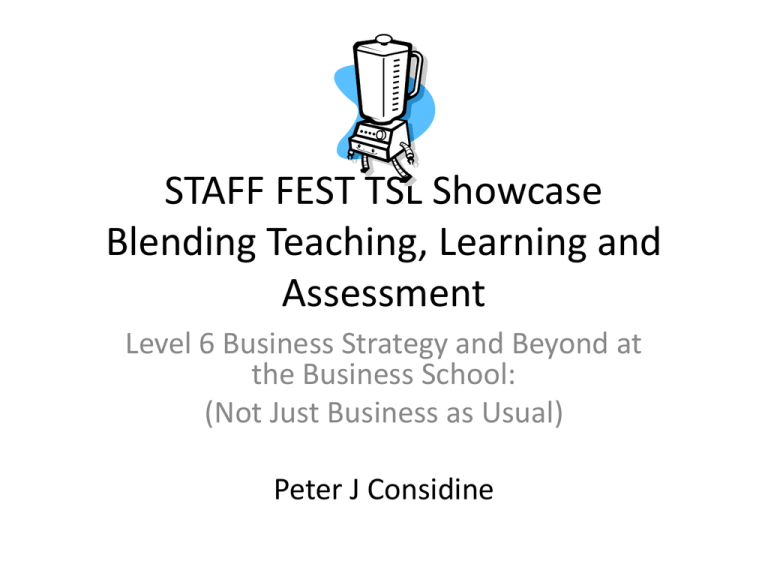
STAFF FEST TSL Showcase Blending Teaching, Learning and Assessment Level 6 Business Strategy and Beyond at the Business School: (Not Just Business as Usual) Peter J Considine Blended Learning with Business, Law and Education • “Blended learning is a half-way house between face-to-face and distance learning, typically used when students are able to attend a college or university for short, relatively intense sessions but cannot attend on a regular basis. • As our relations with various organisations deepens, and as we interact with more diverse student groups in a number of situations, we will need to develop a more common understanding of the frameworks to be used when we talk of blended learning as a strategy” (Faculty of Business, Education and Law “Blended Learning Frameworks” 2014) Approaches to Blending Rossett, Douglis, and Frazee (2003) Learning Circuits Model 1 – “Typical” delivery pattern for a 15 credit module Week Face to Face Lecture Guided Learning Independent Study Assessment Tutorial 1 1 2 1 7 2 1 2 1 7 3 1 2 1 7 4 1 2 1 7 5 1 2 1 7 6 1 2 1 7 7 1 2 1 7 8 1 2 1 7 9 1 2 1 7 10 1 2 1 7 11 1 2 1 7 12 1 2 1 7 9 Totals 12 24 12 84 18 9 150 Model 2 Blended– Reduced class contact and increased Guided Learning Face to Face Totals Lecture 12 Tutorial 12 Guided Learning Independent Study Assessment 48 58 20 150 Model 3 Blended – Further reduction in contact, greater guidance provided Model 4 – Full Distance Learning Face to Face Totals Lecture 6 Tutorial 12 Guided Learning Independent Study Assessment 60 52 20 150 Model 4 – Full Distance Learning (DL programmes often start with a one to many face to face launch) Face to Face Totals Lecture 0 Tutorial 0 Guided Learning Independent Study Assessment 84 46 20 150 A Look at Blending TLA – A case study on L6 Strategic and International Strategic Management: Timeline • • • • • • • • • 2005/6. A blended approach using Blackboard with learning out of class supported by embedded links to Macro Media Contribute 2006/7 Blended Assessment with the introduction of a split assessment including mini-learning portfolios – used until the mandate to have only one assessment point per 15 credits 2008 Computer based Business Simulations (Double Learning and Teaching Fellowship) Project saw the successful introduction of Business Simulations – to 2010 with roll out initially on small group teaching and on large group teaching since 2010 Simulation based learning Student recognition achieved also in the UBC National simulation – four teams through to the Semi finals on the University Business Challenge Above leading to significant improvements in student attainment and satisfaction with learning 2010 on – e-assessment introduced using Turnitin and Grademark 2014 revisiting blended learning as a more immersive blackboard experience 2014 Re-introducing a blended learning and assessment model on a new 30 credit module Business School developing a Blended MBA for corporate clients Traditional On –Campus USE of VLE’s Blackboard as a (quick and dirty) repository • How does this lead to deeper more engaging off campus “blended “learning? • Does the “tutor” think as the “learner” with this drop up one slides approach? • A Nested Hierarchy of sub learning blocks • With Learner Readings, Tasks and • Learning through Games with: • Business Simulations Developing BB VLE as a More Immersive Environment (beyond the repository) 1. Blended Learning Through Guided Study Blocks Developing BB VLE as a More Immersive Environment (beyond the repository) 2. Embedded and E-book supported Learning tasks “Blending” Formative with Summative Students select a portfolio of formative related assessments for e-submission Core Texts Available as E-Books (Dawsonera) ICONIC Blended Learning Activities Readings – included supported e-books Tasks – Individual and Group (Learning Cell) and both Formative and Summative Tasks Completed ! Assessment Design with Learning Portfolios and Strategy Simulations Strategic Management Delivery at Level 3 – Choice of “mini” learning portfolio topics based upon first five weeks of modules programme – Competitive Group Work Project on the Simulation (social constructionist perspectives on learning) – Two further learning portfolio’s with one a being a reflective journal on simulation based learning A Teaching Learning & Assessment model without the traditional (Harvard Business School 1920’s Final case method exam/assignment) Text Based Case Studies (Long & Short) Week 15 Week 14 Week 13 Week 12 Week 11 Week 10 Week 9 Week 8 Week 7 Week 6 Week 5 Week 4 Week 3 Week 2 Week 1 The Traditional Case Based Method (HBS in the 1920’s) In Teaching Strategy and “Case Study Fatigue” in Students – Final Summative Case Study 100 90 80 70 60 50 40 30 20 10 0 Motivation Wk 1 Wk 3 Wk 5 Wk 7 Wk 9 Wk 11 Wk 13 Wk 15 Case Study Fatigue?` Gamification in Pedagogy on Business Strategy : Some Justifications 1 Some years ago Mintzberg & Quinn (1991) contended that: The text based case (TCM) method can be counter productive, by giving misleading, if not even dangerous, over-simplifications of the realities of strategic processes That assessment and output tends to converge upon the lecturer’s own analysis and recommendations. However Faria & Wellington (2004) found from their surveys of former users and users that simulations: – interest and motivate students, – integrate functional areas within a firm and – importantly provide a measure of student comprehension and subject matter understanding. We Introduced Simulations on Strategic Management in 2007 and rolled out on large groups teaching (240 plus students) in 2010. Gamification in Pedagogy on Business Strategy : Some Justifications 2 The Attainment of Functioning and Professional Knowledge • To prepare our students for real life career development and to be on the pathway towards managerial expertise we need to expose them to as much “practice” as possible and which requires closer alignment to award level and module level Learning Outcomes • On Capstone or integrative modules such as Business Strategy, the Leaning outcomes related to functioning knowledge and in particular “Problem Solving” (decision making) & “Reflection” are difficult, (if not impossible), to properly realise using the Traditional Case Method alone. Mini E-Portfolio’s 1 to 3 from a given choice Introduction to StratSim Manager (Automotive context) Initial Situation Briefing For competing Teams Environmental changes /Competitive Moves Input Decisions Period n=1 Internal Changes – Financial data etc. HR = “Team Dynamics” Mid Nov Submission Dec for Interim Summative Feedback Weeks 3/4 Two week trial practice familiarisation of simulation environment Weeks 5 to 11.Team Simulation Assignment Part 1. Initial Assessment/Mission/Strategi es/Tactics Part 2. Decision Output Reports/Strategy Adjustment/Successes/ Issues/ (S) Jan Submission Input Decisions Period n=7 Assessment Model Formative to Summative Business Simulations with E-Portfolios End Game Portfolio 4 Simulation based Portfolio 5 – Reflective Portfolio against LO’s Jan Submission Proposition: Learning Business Strategy: The Role of Simulations in “Top Down” and in “Bottom Up” Learning . University “K”: Declarative, abstract and conceptual (labelling, differentiating, elaborating & Problem Based Learning (PBL)/ or Problem Based Gaming (PBG): Kiili (2007) Professional “K”: (Functioning, specific – deals with executing, applying & making priorities )* Functioning Knowledge justifying) * Conditional Knowledge Declarative knowledge (dominant in Universities): Propositional knowledge – taught/researched knowledge – what we “declare in lectures” e.g. Biggs(2003) SOLO after “extended abstract” * McCarthy Young & Merryman (1995) in Biggs (2011) Subsumes both procedural and higher level declarative knowledge Procedural knowledge: Skill Based, functioning knowledge without a conceptual foundation Welcome to Executive (used in large group learning (240 plus students) A Real Time Simulation based on the European Automotive Industry The Simulation in Overview… You will be working in a team environment to manage an automotive company trading in the European car market. The module will comprise the following elements : PLANNING – Preparing a Strategic Plan, agreeing responsibilities DECISION MAKING – Making five sets of business decisions as a team and to deadlines REVIEWING AND REPORTING – Assessing progress during each year of the simulation and submitting an individual report at the end of the module April Executive Simulations. Year 1 results . Sorted by ROCE % World Team Name Sales Gross Post tax Gross Sales Current Bank ROCE Num (bn) profit (m) Margin % margin % ratio Bal (m) % profit (m) Epsilon 6 Chinese Motors 1.58 631 267 39.80 21.85 0.46 16 109.2 Epsilon 5 Innovation Company 2.60 712 296 27.41 14.87 1.77 424 43.2 Delta 2 SU Motors 2.66 701 225 26.31 10.85 1.30 -8 39.8 Alpha 3 Pro Motor plc. 2.07 557 166 26.87 10.26 1.32 133 32.1 Delta 7 AFCHI 1.75 542 138 30.93 10.10 0.56 45 31.4 Alpha 2 Optimum 1.43 570 227 39.79 21.88 3.03 410 30.5 Delta 5 ecoKINETIC 1.84 543 152 29.41 10.53 1.05 110 29.8 Alpha 1 Zone 1.84 450 146 24.41 10.11 1.39 57 28.9 Gamma 7 Giovanni 2.28 730 175 32.03 10.60 1.56 146 26.2 Beta 8 JASK 1.68 502 148 29.87 11.99 1.95 103 25.9 Delta 1 Aston Motors 2.18 588 216 27.05 14.44 4.42 445 25.8 Gamma 9 Royal PLC 1.90 476 122 25.08 8.23 0.90 110 25.3 Beta 2 Fu 1.20 369 122 30.88 13.12 1.23 101 25.2 Gamma 1 Voyager 2.21 463 154 20.96 9.65 1.84 228 24.9 Iota 1 GoGo Ltd 2.20 498 114 22.59 6.61 1.05 232 23.7 Epsilon 2 Golden Glede 2.44 547 108 22.43 6.00 1.55 88 22.2 Iota 2 BEBBO MOTORS LTD 1.61 380 94 23.65 7.54 1.02 -28 20.4 In total. Typically Some 60 Teams of students compete in Worlds (up to 8 teams per world) and competition for top places across the cohort (games and competition in blending learning) Country Manager (used in smaller group situations on International Strategy – up to 54 students) The International Business Simulation 23 Welcome to Country Manager! CountryManager is an International Marketing simulation focusing on market entry and expansion: • You play the role of Toothpaste Category Manager for a major consumer products company about to enter the Latin American market • For the next ten years, your team will build the “Allsmile” brand in one market and, ultimately, expand into other Latin American markets 24 Develop and implement strategies that are attractive to customers in each country and profitable for Allstar Brands A Move to E-Assessment in 2010 Allocation of scripts from the office to the marking team – significant time spent and now totally time saving with e-assessment Marking on line – use of Rubrics and “quickmark” can save time and will improves consistency in marking on large cohort modules In 2014 with 240 odd students marked completed and released ahead of deadlines. Need to consider ergonomic /H&S issues with extensive PC/Screen work involved in mass on-line marking External have remote access to sample for moderation Marks submitted to students via Grademark and to the office for processing – further time saved and no double entry errors c.f. manual approaches E-assessment via Turnitin (1) Summary of Results of Comparative Study Strategy. Without Simulations Sample 93 students Average Mark: 60.55.% SD: 10.81 Max%: 85.00 % Min%: 18.00 % With Simulations Sample Size: 57 students Average Mark: 63.70% SD: 8.21 Max: 79.00% Min: 40.00 % Individual Case Assignment Element Av: 62.09 % Blending with Simulations has led to a consistent improvement in summative attainment Proposition: Blending TLA, Simulations, Experience and “Deliberate” Practice. Engaged Learners More Prepared for Professional Practice Adapted from Ericsson (2007) 3. “Expert Performance” Performance . 2. The UG Intermediary? Generative/Experiential Learning via Blending TLA with Business Games/Simulations. The workplace ready “Staffordshire Graduate” 1. The Novice “Studies on students’ perceptions of learning in business simulations often suggest that students like simulations and view them more positively than both lectures and case discussions” Palmunen et al (2013) Experience (time) Blending How do you blend? (adapted from • • • • • • • • • • • • There’s no cookbook for blends. The topic calls out for empirical research, stymied to date by murky definitions for blends and their ingredients, as well as the normal challenges associated with workplace studies. In the meantime, here are some guidelines for thinking about and constructing successful combinations. Derived from experience, observations of best practices, and the instructional design literature, these approaches highlight real constraints. Stability and urgency. Will this content last for one or two years? Will there be changes within days or weeks? A good distinction to remember is that product information tends to be fickle, while such concepts as a perspective on leadership or customer service possess more staying power. Another consideration is the amount of time developers have to create the belnd's ingredients. Does the program need to be up and running within five days or will there be several months to design and develop assets for the blend? Rossett, Felicia, Douglis, and Frazee (2003) Going Blended on TLA Costs and Time Rossett, Felicia, Douglis, and Frazee (2003) Some Concluding Thoughts (1) • Blending is a mix of approaches to engaging our learners • To support out of classroom/off campus engagement we need to develop our VLE’s beyond being a repository into a more structured (hierarchal) and immersive learning environment, with clear specified and supported learning environments • This immersive design can be done with environments such as Blackboard (an ever evolving if clunky application) but such can support embedded and more suitable applications such as “Contribute”. • Blending Assessments. Going beyond the traditional final summative case based approach has been found to improve student attainment (the use of choice of eportfolios and which however required more than one assessment point per 15 credits or a 30 credit module) Some Concluding Thoughts (2) • E-assessments complement the blend enabling students to submit remote from the campus • Blending with Simulations. Team/game based (social learning) pedagogies most certainly engages our students through competitive real world scenarios • Learning through Simulations aligns with students acquiring “real world” or “functioning knowledge”, beyond the novice and aligns with the Staffordshire Graduate. • In the case of introducing and then rolling out to large cohorts simulation based learning requires a certain amount of courage, but once up and running it is well worth it Some Concluding Thoughts (3) • However such developments put the tutor in the shoes of the learner and with simulations the tutor becomes a colearner/consultant (relates well a virtual form of practice based learning). • Developing more immersive approaches to asynchronous learning will take time (and cost) • Other complementary techniques include “Flipping the Class Room” and by challenging delivery patterns – (blending teaching). • Piloting and encouraging innovations in blending learning approaches alongside having a School/Faculty wide set of guiding principles is important Readings • • • • • • • • • • • • • • Biggs, J. (2011) Teaching for Quality Learning at University Open University Press Bragge, Precha Thavikulwat and Juuso Töyli (2013) Profiling 40 Years of Research in Simulation & Gaming. Simulation and Gaming Vol 41(6) 848-868 Ericsson, Charness, Feltovich & Hoffman (2007). The Cambridge Handbook of Expertise and Expert Performance; Cambridge University Press Faria & Wellington (2004). A survey of simulation game users, former users, and never users. Simulation & Gaming, Vol 35, 782007 Fortmuller, R. (2009) Learning through Business Games: Acquiring Competences Within Virtual Realities. Simulation & Gaming Vol. 40, No1,68-73 Jennings, D.R. (2001) Strategic management: An evaluation of the use of three learning methods. Journal of Management Development. Vol. 21. No9, 655-665 Kiili (2007). Foundation for problem-based gaming. British Journal of Educational Technology Vol 38, 394-404 Mitchell (2004). Combining cases and computer simulations in strategic management course. Journal of Education for Business, Vol. 79, 198-204 Mintzberg, Qunin & Ghosal (1991) Strategy Process, Context and Concepts. Palmunen, Pelto, Paalumäki and Lainema. (2013) Formation of Novice Business Students’ Mental Models Through Simulation Gaming. Simulation and Gaming. Vol 44(6) 846–868 Rossett, Douglis, and Frazee (2003) Learning Circuits (on line subscritpion) http://ablendedmaricopa.pbworks.com/f/Strategies%20Building%20Blended%20Learning.pdf (accessed 17th June 2014 Wittrock, M C. (1985). Teacher learner generative strategies for enhancing reading comprehension. Theory Into Practice, Vol. 24. no 2: 123-126 Wortley (2013) Immersive Technology Strategies. Simulation and Gamming Vol 44, 869-881 Towler (2007). An exploration of student perception of a business simulation game. The International Journal of Management Education 7, 69-79


